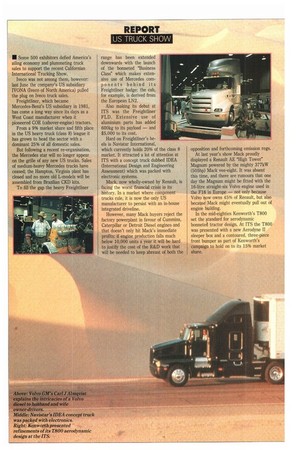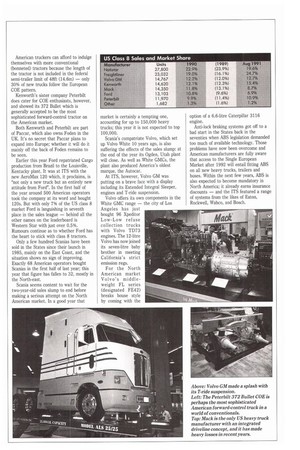REPORT
Page 48

Page 50

If you've noticed an error in this article please click here to report it so we can fix it.
US TRUCK SHOW
IN Some 500 exhibitors defied America's ailing economy and plummeting truck sales to support the recent Californian International Trucking Show.
Iveco was not among them, however: last June the company's US subsidiary IVONA (Iveco of North America) pulled the plug on Iveco truck sales.
Freightliner, which became Mercedes-Benz's US subsidiary in 1981, has come a long way since its days as a West Coast manufacturer when it pioneered COE (cabover-engine) tractors. From a 9% market share and fifth place in the US heavy truck (class 8) league it has grown to head the sector with a dominant 25% of all domestic sales. But following a recent re-organisation, the Mercedes star will no longer appear on the grille of any new US trucks. Sales of medium-heavy Mercedes trucks have ceased; the Hampton, Virginia plant has closed and no more old L-models will be assembled from Brazilian CKD kits. To fill the gap the heavy Freightliner range has been extended downwards with the launch of the bonneted "Business Class" which makes extensive use of Mercedes components behind its Freightliner badge: the cab, for example, is derived from the European LN2.
Also making its debut at ITS was the Freightliner FLD. Extensive use of aluminium parts has added 600kg to its payload — and $5,000 to its cost.
Hard on Freightliner's heels is Navistar International, which currently holds 20% of the class 8 market. It attracted a lot of attention at ITS with a concept truck dubbed IDEA (International Design and Engineering Assessment) which was packed with electronic systems.
Mack, now wholly-owned by Renault, is facing the worst financial crisis in its history. In a market where component trucks rule, it is now the only US manufacturer to persist with an in-house integrated driveline.
However, many Mack buyers reject the factory powerplant in favour of Cummins, Caterpillar or Detroit Diesel engines and that doesn't only hit Mack's immediate profits: if engine production falls much below 10,000 units a year it will be hard to justify the cost of the R&D work that will be needed to keep abreast of both the opposition and forthcoming emission regs.
At last year's show Mack proudly displayed a Renault AE 'High Tower" Magnum powered by the mighty 377kW (505hp) Mack vee-eight. It was absent this time, and there are rumours that one day the Magnum might be fitted with the 16-litre straight-six Volvo engine used in the F16 in Europe — not only because Volvo now owns 45% of Renault, but also because Mack might eventually pull out of engine building.
In the mid-eighties Kenworth's 1800 set the standard for aerodynamic bonneted tractor design. At ITS the T800 was presented with a new Aerodyne II sleeper box and a contoured, three-piece front bumper as part of Kenworth's campaign to hold on to its 15% market share. American truckers can afford to indulge themselves with more conventional (bonneted) tractors because the length of the tractor is not included in the federal semi-trailer limit of 48ft (14.6m) — only 30% of new trucks follow the European COE pattern.
Kenworth's sister company Peterbilt does cater for COE enthusiasts, however, and showed its 372 Bullet which is generally accepted to be the most sophisticated forward-control tractor on the American market.
Both Kenworth and Peterbilt are part of Paccar, which also owns Foden in the UK. It's no secret that Paccar plans to expand into Europe; whether it will do it mainly off the back of Foden remains to be seen.
Earlier this year Ford repatriated Cargo production from Brazil to the Louisville, Kentucky plant. It was at ITS with the new AeroMax 120 which, it proclaims, is "not only a new truck but an entirely new attitude from Ford". In the first half of the year around 500 American operators took the company at its word and bought 120s. But with only 7% of the US class 8 market Ford is languishing in seventh place in the sales league — behind all the other names on the leaderboard is Western Star with just over 0.5%. Rumours continue as to whether Ford has the heart to stick with class 8 tractors.
Only a few hundred Scanias have been sold in the States since their launch in 1985, mainly on the East Coast, and the situation shows no sign of improving. Exactly 68 American operators bought Scanias in the first half of last year; this year that figure has fallen to 32, mostly in the North-east.
Scania seems content to wait for the two-year-old sales slump to end before making a serious attempt on the North American market. In a good year that market is certainly a tempting one, accounting for up to 150,000 heavy trucks; this year it is not expected to top 100,000.
Scania's compatriate Volvo, which set up Volvo White 10 years ago, is also suffering the effects of the sales slump: at the end of the year its Ogden, Utah plant will close. As well as White GMCs, the plant also produced America's oldest marque, the Autocar.
At ITS, however, Volvo GM was putting on a brave face with a display including its Extended Integral Sleeper, engines and T-ride suspension.
Volvo offers its own components in the White GMC range — the city of Los Angeles has just bought 96 Xpeditor Low-Low refuse collection trucks with Volvo TD73 engines. The 12-litre Volvo has now joined its seven-litre baby brother in meeting California's strict emission regs.
For the North American market Volvo's middleweight FL series (designated FE42) breaks house style by coming with the option of a 6.6-litre Caterpillar 3116 engine.
Anti-lock braking systems got off to a bad start in the States back in the seventies when ABS legislation demanded too much of available technology. Those problems have now been overcome and American manufacturers are fully aware that access to the Single European Market after 1992 will entail fitting ABS on all new heavy trucks, trailers and buses. Within the next few years, ABS is also expected to become mandatory in North America; it already earns insurance discounts — and the ITS featured a range of systems from the likes of Eaton, Rockwell, Wabco, and Bosch.
































































































